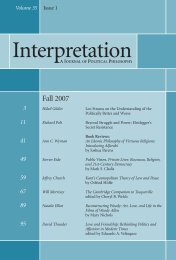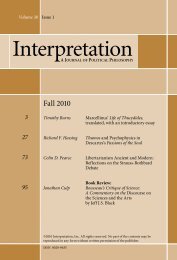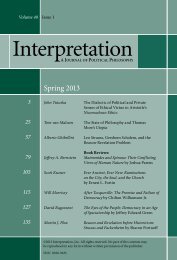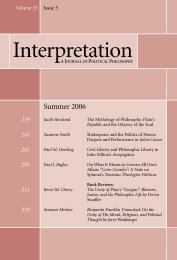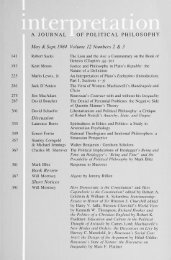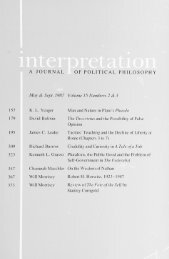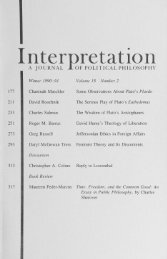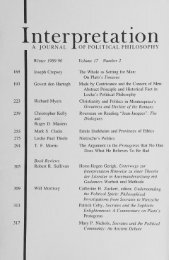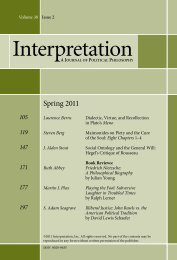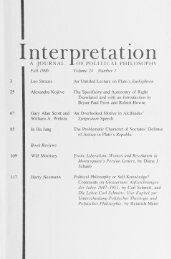Spring 2010 - Interpretation
Spring 2010 - Interpretation
Spring 2010 - Interpretation
You also want an ePaper? Increase the reach of your titles
YUMPU automatically turns print PDFs into web optimized ePapers that Google loves.
3 2 6<br />
I n t e r p r e t a t i o n<br />
forms of religiosity, whereas Jefferson would only recognize faiths whose<br />
catechisms could pass his rational-basis test. It is worth asking, however,<br />
whether Jefferson would really be as willing to apply this element of Jeffersonianism<br />
to the nation, where the religious demographics were unfavorable<br />
for his desired outcome, as to “Mr. Jefferson’s University,” where his influence<br />
was much greater. As president, Jefferson typically acted and sounded more<br />
Madisonian than even Madison did. And so, while identifying this particular<br />
strand of Jeffersonianism is a useful tool for Muñoz’s analysis, it is difficult<br />
to align it as closely with the third president’s overall church-state philosophy<br />
as the other two approaches can reasonably be linked to Madison and<br />
Washington (as Muñoz recognizes in a clever index entry titled, “Jefferson,<br />
contradictions in”).<br />
In an important contribution to the current religious freedom<br />
debate, Muñoz describes how religious accommodation was not a<br />
particular concern of any of these framers. After a review of the three Virginians<br />
on the subject of indirect burdens—such as compulsory schooling<br />
requirements—and exemptions—whether there should be, for example,<br />
conscientious exemptions for military service—Muñoz concludes that none<br />
of them would support such constitutional rights, and only Washingtonianism<br />
would even allow legislatures to create statutory exemptions. Here the<br />
Supreme Court’s decisions to free the Amish from compulsory schooling<br />
or Jehovah’s Witnesses from saluting the flag are considerably more accommodating<br />
than the Virginia framers. In sum, it is difficult to find support<br />
from any of these three founders for insulating the devout from generally<br />
applicable laws.<br />
In the end, Muñoz concludes that there was no single comprehensive<br />
church-state viewpoint shared by the founding generation, but,<br />
nevertheless, the framers “can serve as a rich source of ideas and understandings<br />
about religion and the proper separation of church and state” (221). The<br />
same can be said of Muñoz’s own contribution to our study of religion and<br />
the republic, which is strikingly clear and well written for someone schooled<br />
deeply in political philosophy, yet thoughtfully nuanced for one so willing to<br />
plunge into constitutional controversies. Muñoz has provided us with one of<br />
the few genuinely original contributions to a field that has felt overcrowded<br />
and redundant for several decades. That every reader will find something<br />
interesting with which to wrestle is a tribute to his ability to shed new light on<br />
old subjects in a way that provokes a much needed reawakening of the field.



